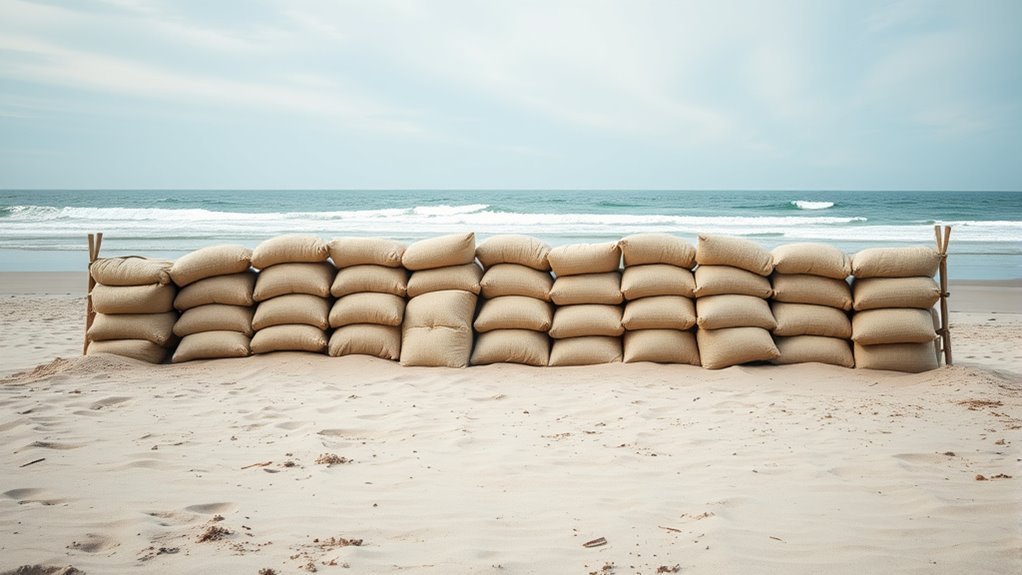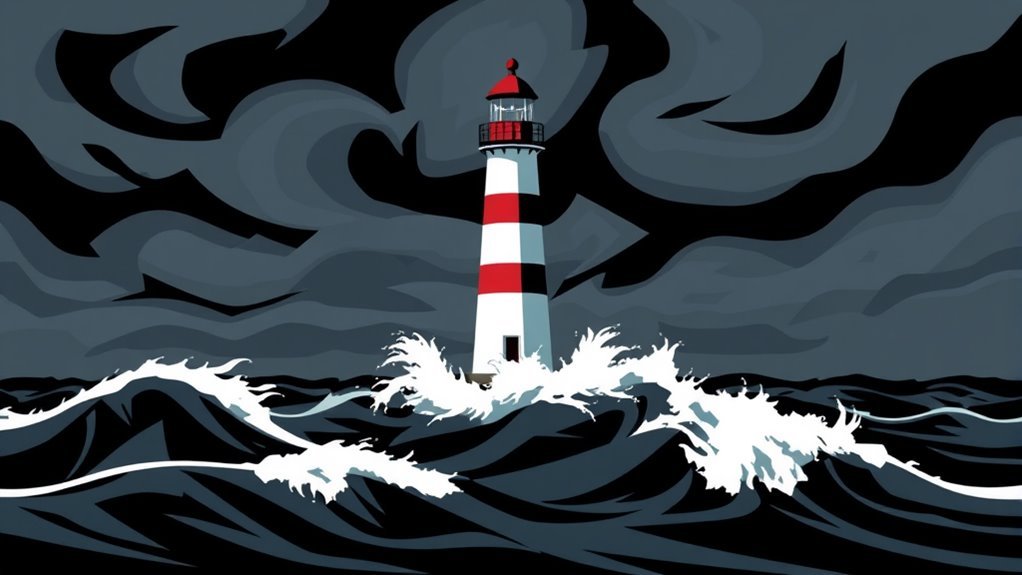Coastal communities brace for squalls by strengthening building codes and investing in storm-resistant infrastructure. They employ durable materials, design wind-resistant structures, and upgrade drainage systems. Community preparedness initiatives educate residents on emergency plans and securing properties. Emergency response plans guarantee coordination among local agencies. Cutting-edge technologies improve weather monitoring, providing timely alerts. Collaborating with environmental organizations, they implement natural solutions for resilience. There are more effective strategies and partnerships shaping these efforts to investigate further.
Main Points
- Coastal communities implement stringent building codes requiring durable materials and wind-resistant designs to enhance structural resilience against squalls.
- Emergency preparedness workshops educate residents on creating disaster plans, assembling supply kits, and securing properties against strong winds.
- Advanced weather monitoring technologies provide real-time storm tracking and alerts, enabling timely community responses to incoming squalls.
- Collaboration with environmental organizations promotes sustainable practices and natural solutions, such as restoring wetlands to act as buffers against wind damage.
- Regular community drills and training sessions ensure residents and emergency responders are well-prepared for squall-related emergencies.
Understanding the Impact of Squalls on Coastal Areas
Although squalls may be brief, their impact on coastal areas can be substantial and often devastating. These sudden, intense storms are defined by strong winds and heavy rain, which can lead to considerable damage. Coastal communities frequently experience uprooted trees, damaged infrastructure, and destruction of property due to the sheer force of the winds.
Moreover, squalls can exacerbate coastal erosion, undermining shorelines and increasing vulnerability to subsequent storms. The rapid onset of squalls can catch residents off guard, leaving little time for preparation or evacuation.
In addition to physical damage, the aftermath can strain local resources, as emergency services may be overwhelmed by the extent of destruction. The economic consequences are equally troubling, as businesses may face closures and residents may incur costly repairs.
Understanding the nature and risks of squalls is essential for coastal communities aiming to mitigate their impact and improve preparedness strategies.
Strengthening Building Codes for Enhanced Safety

Strengthening building codes is essential for enhancing safety in coastal communities prone to wind damage.
By implementing improved material standards and incorporating wind-resistant design features, structures can better withstand the forces of nature.
This proactive approach not only protects lives but also reduces economic losses following severe weather events.
Improved Material Standards
As coastal communities face increasing threats from wind damage, the implementation of improved material standards has become essential for enhancing safety.
Local governments and building authorities are revising codes to mandate the use of durable materials that can withstand extreme weather conditions. This includes higher-grade roofing, impact-resistant windows, and reinforced structural components.
By establishing stringent criteria for materials, communities aim to reduce the risk of catastrophic failures during severe storms. Moreover, collaboration with manufacturers guarantees that building materials meet or exceed these new standards.
Such proactive measures not only protect lives but also minimize economic losses associated with wind damage. In the end, improved material standards serve as a critical line of defense against the unpredictable forces of nature that coastal areas encounter.
Wind-Resistant Design Features
While the implementation of improved material standards is essential, incorporating wind-resistant design features into building codes is equally important for coastal communities facing wind damage.
These features, such as aerodynamic roof shapes and reinforced structural elements, greatly improve a building's ability to withstand strong winds. Additionally, the strategic placement of windows and doors can reduce vulnerability, while employing hurricane ties and straps guarantees that roofs remain securely attached during storms.
Moreover, raised foundations help mitigate flooding risks, a critical consideration in coastal areas. By updating building codes to mandate these design features, communities can not only protect lives and property but also reduce long-term recovery costs and bolster resilience against increasingly severe weather events.
Investing in Storm-Resistant Infrastructure
Many coastal communities are recognizing the urgent need to invest in storm-resistant infrastructure to mitigate the devastating effects of wind damage. This investment includes the construction of buildings designed to withstand high winds, utilizing materials such as reinforced concrete and impact-resistant windows.
Additionally, many communities are focusing on enhancing their drainage systems to manage heavy rainfall and prevent flooding.
Local governments are also prioritizing the development of resilient transportation networks, ensuring that evacuation routes are accessible during severe weather events. Upgrading utility poles and burying power lines further reduces the risk of outages during storms.
Moreover, integrating green infrastructure, such as coastal wetlands and dune restoration, can provide natural barriers against storm surges and high winds.
Community Preparedness: Educating Residents

Community preparedness is crucial for coastal residents facing wind damage.
Emergency preparedness workshops can equip individuals with essential skills and knowledge, while community resource networks promote collaboration and support.
Together, these initiatives improve resilience and guarantee residents are well-informed in the face of impending storms.
Emergency Preparedness Workshops
As coastal communities face increasing threats from wind damage, the importance of emergency preparedness workshops cannot be overstated.
These workshops serve as essential platforms for educating residents about effective strategies for safeguarding their homes and families. Participants learn how to create emergency plans, assemble disaster supply kits, and identify safe evacuation routes.
Furthermore, workshops often include demonstrations on securing property against strong winds, such as reinforcing windows and doors. By cultivating a culture of preparedness, these initiatives enable residents to respond confidently during severe weather events.
Additionally, they encourage community engagement and cooperation, helping residents build connections that can be essential during emergencies.
In the end, such workshops play a significant role in enhancing resilience within vulnerable coastal populations.
Community Resource Networks
Building on the foundation established by emergency preparedness workshops, community resource networks play a key role in enhancing residents' readiness for wind damage and other disasters.
These networks consist of local organizations, volunteers, and government agencies that collaborate to provide essential resources and information. They promote communication among residents, ensuring that critical updates regarding severe weather are disseminated quickly and effectively.
Additionally, these networks organize training sessions, distribute emergency supplies, and create response plans tailored to community needs. By nurturing connections and promoting shared knowledge, community resource networks enable residents to take proactive measures, ultimately reducing vulnerability to wind damage and enhancing overall resilience in the face of natural disasters.
Emergency Response Plans: Coordinating Efforts

While the threat of wind damage looms over coastal areas, effective emergency response plans are essential for mitigating its impact. These plans rely on coordinated efforts among local government agencies, emergency services, and community organizations.
Clear communication channels are established to guarantee timely dissemination of critical information regarding impending storms and safety measures.
Regular training exercises and simulations help prepare responders for real-life scenarios, encouraging teamwork and enhancing efficiency. Additionally, community engagement is crucial; residents are educated about evacuation routes, emergency shelters, and resource availability.
Coordination between local, state, and federal entities further strengthens response capabilities, assuring that resources are allocated effectively.
By integrating technology and utilizing real-time data, communities can modify their strategies as conditions evolve.
In the end, thorough emergency response plans not only safeguard lives but also bolster the resilience of coastal communities facing the unpredictability of wind damage.
Innovative Technologies for Weather Monitoring
Advancements in groundbreaking technologies have considerably improved weather monitoring capabilities, providing coastal communities with critical tools to predict and respond to wind damage. High-resolution satellite imagery and advanced radar systems enable real-time tracking of storm systems, allowing for timely alerts to residents and local authorities.
Additionally, the integration of Internet of Things (IoT) gadgets has resulted in the establishment of localized weather stations that collect data on wind speed, direction, and atmospheric pressure. These stations improve the accuracy of forecasts, enabling communities to prepare more effectively for impending squalls.
Furthermore, machine learning algorithms analyze extensive amounts of meteorological data, enhancing predictive models and helping to identify potential threats before they escalate. By leveraging these cutting-edge technologies, coastal communities can mitigate risks associated with wind damage, ultimately boosting resilience and ensuring a more informed response when severe weather strikes.
Collaborating With Environmental Organizations
Collaborating with environmental organizations is crucial for coastal communities seeking to strengthen their resilience against wind damage. These partnerships enable access to essential resources, including knowledge in sustainable practices and creative strategies for disaster preparedness.
Environmental organizations often provide funding opportunities, research, and technical support, helping communities to develop robust infrastructure that can withstand severe weather events.
Additionally, these collaborations encourage awareness and education around best practices for land use and environmental conservation, which can mitigate the impacts of wind storms. By working together, coastal communities can implement effective natural solutions, such as restoring wetlands or planting trees, which serve as buffers against strong winds.
Moreover, these alliances cultivate a sense of shared responsibility, encouraging community members to actively participate in resilience-building efforts.
In the end, through collaboration with environmental organizations, coastal communities can improve their defenses against wind damage while contributing to broader ecological sustainability.
Common Questions
How Do Coastal Communities Recover Financially After Severe Squalls?
Coastal communities often rely on federal aid, insurance claims, and community fundraising to recover financially after severe squalls. They also implement long-term planning and resilience strategies to mitigate future financial impacts from similar disasters.
What Types of Insurance Are Essential for Coastal Residents?
Coastal residents require various essential insurance types, including homeowners, flood, and windstorm insurance. These policies provide vital financial protection against potential damages from severe weather events, ensuring communities can recover and rebuild effectively after disasters.
How Can Individuals Contribute to Local Storm Preparedness Efforts?
Individuals can improve local storm preparedness by volunteering for community drills, participating in education programs, organizing neighborhood watch groups, sharing resources, and advocating for infrastructure improvements, cultivating a culture of resilience and collective responsibility among residents.
Are There Specific Plants That Help Reduce Wind Damage in Coastal Areas?
Certain plants, such as salt-tolerant grasses, mangroves, and coastal shrubs, can help reduce wind damage in coastal areas. Their dense root systems and foliage act as natural barriers, stabilizing soil and protecting against strong winds.
What Role Do Local Businesses Play in Emergency Response Planning?
Local businesses considerably contribute to emergency response planning by providing resources, knowledge, and support. Their involvement promotes community resilience, improves communication networks, and guarantees essential services remain operational during crises, ultimately benefiting the entire locality.

